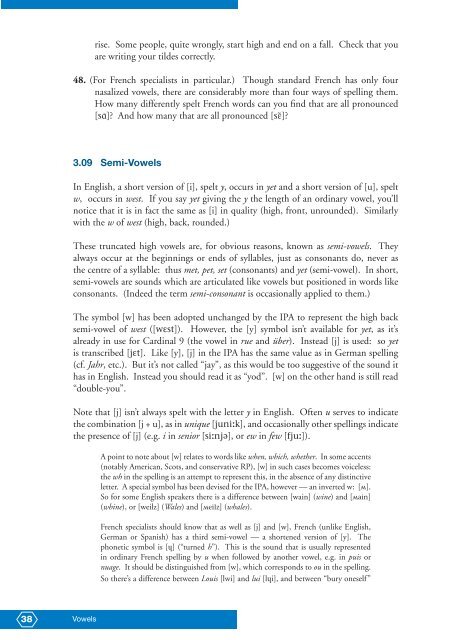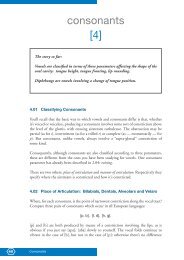PHONETICS MANUAL.indd - HumBox
PHONETICS MANUAL.indd - HumBox
PHONETICS MANUAL.indd - HumBox
You also want an ePaper? Increase the reach of your titles
YUMPU automatically turns print PDFs into web optimized ePapers that Google loves.
ise. Some people, quite wrongly, start high and end on a fall. Check that you<br />
are writing your tildes correctly.<br />
48. (For French specialists in particular.) Though standard French has only four<br />
nasalized vowels, there are considerably more than four ways of spelling them.<br />
How many differently spelt French words can you find that are all pronounced<br />
[s]? And how many that are all pronounced [s]?<br />
3.09 Semi-Vowels<br />
In English, a short version of [i], spelt y, occurs in yet and a short version of [u], spelt<br />
w, occurs in west. If you say yet giving the y the length of an ordinary vowel, you’ll<br />
notice that it is in fact the same as [i] in quality (high, front, unrounded). Similarly<br />
with the w of west (high, back, rounded.)<br />
These truncated high vowels are, for obvious reasons, known as semi-vowels. They<br />
always occur at the beginnings or ends of syllables, just as consonants do, never as<br />
the centre of a syllable: thus met, pet, set (consonants) and yet (semi-vowel). In short,<br />
semi-vowels are sounds which are articulated like vowels but positioned in words like<br />
consonants. (Indeed the term semi-consonant is occasionally applied to them.)<br />
The symbol [w] has been adopted unchanged by the IPA to represent the high back<br />
semi-vowel of west ([wEst]). However, the [y] symbol isn’t available for yet, as it’s<br />
already in use for Cardinal 9 (the vowel in rue and über). Instead [j] is used: so yet<br />
is transcribed [jEt]. Like [y], [j] in the IPA has the same value as in German spelling<br />
(cf. Jahr, etc.). But it’s not called “jay”, as this would be too suggestive of the sound it<br />
has in English. Instead you should read it as “yod”. [w] on the other hand is still read<br />
“double-you”.<br />
Note that [j] isn’t always spelt with the letter y in English. Often u serves to indicate<br />
the combination [j + u], as in unique [juni:k], and occasionally other spellings indicate<br />
the presence of [j] (e.g. i in senior [si:nj@], or ew in few [fju:]).<br />
A point to note about [w] relates to words like when, which, whether. In some accents<br />
(notably American, Scots, and conservative RP), [w] in such cases becomes voiceless:<br />
the wh in the spelling is an attempt to represent this, in the absence of any distinctive<br />
letter. A special symbol has been devised for the IPA, however — an inverted w: [˜].<br />
So for some English speakers there is a difference between [wain] (wine) and [˜ain]<br />
(whine), or [weilz] (Wales) and [˜eilz] (whales).<br />
French specialists should know that as well as [j] and [w], French (unlike English,<br />
German or Spanish) has a third semi-vowel — a shortened version of [y]. The<br />
phonetic symbol is [] (“turned h”). This is the sound that is usually represented<br />
in ordinary French spelling by u when followed by another vowel, e.g. in puis or<br />
nuage. It should be distinguished from [w], which corresponds to ou in the spelling.<br />
So there’s a difference between Louis [lwi] and lui [li], and between “bury oneself”<br />
38 Vowels






